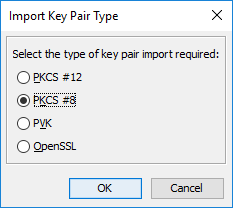

- #Convert pfx to pem and key keystore explorer how to
- #Convert pfx to pem and key keystore explorer password
- #Convert pfx to pem and key keystore explorer plus
- #Convert pfx to pem and key keystore explorer download

Ix) Add the truststore location to your Dockerfile as a JDK start up parameter as seen belowĭ=/mnt/devdir/comp-dev-truststore.
#Convert pfx to pem and key keystore explorer password
Viii) Configure your secrets with the keystore password and truststore password keytool export PWcat password Create a JKS keystore that trusts the example. Create a new keystore named mykeystore and load the private key located in the testkey.pem file. export PWcat password Create a self signed key pair root CA certificate. Command : cat testcert.pem CertGenCA.pem > newcerts.pem 4. Concatenate the certificate and the Certificate Authority (CA). Vii) Configure your config maps with appropriate values for the keystore name, keystore alias and truststore name Convert the certificate from DER format to PEM format. Vi) Ensure the keystore files are on the worker nodes If you created the file clientprivcert.pem (containing the client certificate, the private key, and any intermediate certificates), then converting the file to PKCS12 is simple: openssl pkcs12 -export -in clientprivcert.pem -out clientprivcert. V) Upload the keystore files to the Secure API s3 Bucket and also to the directory specified on the worker nodes (this is executed as part of the terraform script) Like PEM format, PKCS12 format supports having all your certificates and your private key in one file. Iv) Create a JKS file for the truststore and add the root and intermediate certificates
#Convert pfx to pem and key keystore explorer download
Iii) Download DigiCert Root and Intermediate Certificates from The Digicert Portal Keytool -importkeystore -srckeystore -srcstoretype pkcs12 - destkeystore comp-dev-keystore.jks -deststoretype JKS Ii) Convert certificate from pfx to keystore jks using the following command: pfx client certificate from the Comp admin portal Apply X.509 certificate extensions to generated key pairs and Certificate Signing Requests (CSRs). Openssl x509 -inform der -in gen/qa_r -out gen/qa_cert.pem 2.) Apply DigiCert certificate to the Switch Environment Generate RSA, EC and DSA key pairs with self-signed X.509 certificates. Keytool -export -alias apis01.qa -file gen/qa_r -keystore cert_keystore.jks Openssl pkcs12 -in gen/qa_keystore.p12 -nodes -nocerts -out gen/qa_key.key Keytool -importkeystore -alias apis01.qa -srckeystore cert_keystore.jks -destkeystore gen/qa_keystore.p12 -deststoretype PKCS12 <<”sandbox.p7r”<< d.) Generate the PEM and key with the following keytool and openssl commands
#Convert pfx to pem and key keystore explorer plus
#Convert pfx to pem and key keystore explorer how to
here is how to do it so that the resulting single file contains the decrypted private key so that something like HAProxy can use it without prompting you for passphrase. Another perspective for doing it on Linux.


 0 kommentar(er)
0 kommentar(er)
